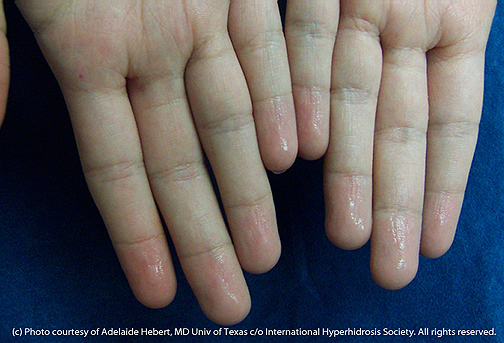Finest Dermatology Approaches for Sweaty Hands Treatment: Tips and Techniques
Finest Dermatology Approaches for Sweaty Hands Treatment: Tips and Techniques
Blog Article
Unveiling the Complexities of Excessive Sweating: A Comprehensive Guide to Medical Diagnosis and Administration
Too much sweating, clinically called hyperhidrosis, is a problem that affects a significant number of individuals and can have a profound influence on their quality of life. While sweating is an all-natural bodily feature, its overactivity in hyperhidrosis offers a special collection of challenges that often exceed mere pain. Comprehending the underlying causes, recognizing the signs, and navigating the diagnostic process for hyperhidrosis can be detailed tasks. In this extensive overview, we will discover the intricacies of hyperhidrosis, from its medical diagnosis to the selection of treatment options offered, losing light on efficient administration strategies for those grappling with this condition.

Recognizing Hyperhidrosis Causes
Hyperhidrosis triggers can be associated to numerous factors such as genetics, hormone inequalities, and particular medical conditions. Genetics play a substantial duty in main focal hyperhidrosis, where people acquire the condition from their member of the family. This kind of hyperhidrosis commonly materializes in details locations like the hands, soles of the feet, underarms, and face. Hormonal imbalances, specifically an overactive thyroid gland or menopausal changes, can likewise activate extreme sweating. Furthermore, particular medical conditions such as diabetic issues, heart disease, and infections can cause secondary generalized hyperhidrosis. These underlying health problems can interrupt the body's all-natural cooling system, causing the sweat glands to come to be over active. Understanding the source of hyperhidrosis is important in diagnosing and efficiently managing this problem. By determining the particular factors adding to excessive sweating, health care companies can customize treatment strategies to resolve the underlying cause, offering relief and improving the lifestyle for individuals affected by hyperhidrosis.
Acknowledging Hyperhidrosis Symptoms

Additionally, hyperhidrosis signs may materialize in social and psychological distress, as people might feel humiliated or anxious concerning their sweating, bring about evasion of social situations (How to stop sweaty hands). Additionally, duplicated episodes of too much sweating can lead to skin maceration, fungal infections, and a general decrease in self-esteem
Diagnostic Refine for Hyperhidrosis
Launching the diagnostic process for extreme sweating includes thorough examination of the person's medical history and health examination. Asking about the onset, use this link period, and triggers of sweating episodes is essential to separate in between main focal hyperhidrosis and secondary generalised hyperhidrosis. Clinical background ought to additionally consist of questions about drugs, clinical conditions, and family background of hyperhidrosis.
Throughout the physical exam, particular focus is paid to the areas impacted by click for source sweating. The doctor may examine the extent of sweating, look for signs of underlying conditions, and assess the effect of sweating on the person's lifestyle. Additionally, certain tests like the gravimetric test, starch-iodine examination, or skin conductance dimensions may be conducted to measure the quantity of sweat created.
Moreover, in situations where additional hyperhidrosis is thought, additional examinations such as blood examinations, urine tests, and imaging studies may be advised to identify the underlying source of too much sweating. The diagnostic process intends to precisely figure out the type and reason for hyperhidrosis to direct ideal monitoring techniques.
Treatment Choices for Hyperhidrosis
When addressing too much sweating, various therapy alternatives are readily available to reduce signs and symptoms and enhance the individual's top quality of life. The treatment method for hyperhidrosis depends on the intensity of signs and the individual's feedback to first treatments.
Topical therapies, such as aluminum-based antiperspirants, are often recommended as the initial line of protection for taking care of light situations of hyperhidrosis. For people with extra extreme signs and symptoms, oral medicines like anticholinergics may be prescribed to help decrease sweating.

Effective Administration Methods
To successfully manage hyperhidrosis, a individualized and comprehensive treatment plan tailored to the client's certain requirements and response to previous treatments is look at this site important. Iontophoresis, involving the use of a reduced electric existing to lower sweat gland task, can be helpful for both palmoplantar and axillary hyperhidrosis. A multidisciplinary approach including skin doctors, primary care doctors, and, if essential, doctors, can maximize the administration of hyperhidrosis.
Conclusion
In final thought, hyperhidrosis is a condition characterized by extreme sweating, which can considerably affect an individual's quality of life. With correct medical diagnosis and administration methods, individuals experiencing from hyperhidrosis can find relief and boost their general well-being.
Extreme sweating, medically recognized as hyperhidrosis, is a problem that influences a substantial number of individuals and can have a profound impact on their quality of life. By identifying the specific aspects contributing to too much sweating, medical care service providers can tailor treatment plans to attend to the underlying cause, providing relief and enhancing the top quality of life for people influenced by hyperhidrosis.
Hyperhidrosis, identified by extreme sweating beyond what is necessary for regulating body temperature level, can significantly impact an individual's quality of life. Making inquiries about the start, duration, and activates of sweating episodes is important to separate between main focal hyperhidrosis and additional generalised hyperhidrosis. How to stop sweaty hands.In conclusion, hyperhidrosis is a condition identified by extreme sweating, which can significantly affect a person's quality of life
Report this page